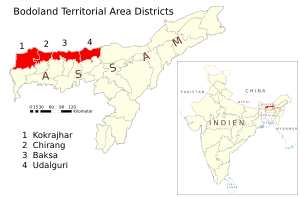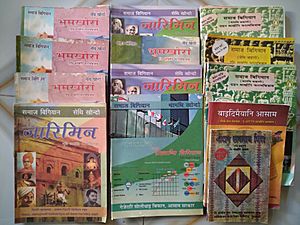Boro language (India) facts for kids
Quick facts for kids Boro |
|
|---|---|
| Bodo बरʼ, बड़ो |
|

The words Boro Rao (Boro language) written in Devanagari script
|
|
| Native to | Northeast India |
| Region | Bodoland (Assam) |
| Ethnicity | Boro people |
| Native speakers | 1.4 million (2011 census) |
| Language family |
Sino-Tibetan
|
| Writing system | Devanagari (official) Eastern Nagari (contemporary) Latin (contemporary) |
| Official status | |
| Official language in | |
 |
|
| Part of a series on | |
|---|---|
|
|
|
| Constitutionally recognised languages of India | |
| Category | |
| 22 Official Languages of the Indian Republic | |
| Related | |
|
|
The Boro (बरʼ or बड़ो) language, also called Bodo, is a Sino-Tibetan language. It is mainly spoken by the Boros in Northeast India. You can also find speakers in nearby Nepal and Bangladesh.
Boro is an official language in the Indian state of Assam. It is mostly spoken in the Bodoland Territorial Region. It is also one of the 22 languages listed in the Eighth Schedule of the Constitution of India. Since 1975, the language has been written using the Devanagari script. Before that, it was written using Latin and Eastern-Nagari scripts. Some experts think the language once had its own script called Deodhai, but it is now lost.
Contents
History of Boro Language
Since 1913, different Boro groups worked hard to promote their language. Because of their efforts, Boro was introduced in primary schools in Boro areas in 1963.
Today, Boro is used to teach students up to the secondary level. It is also an official language in Assam. You can even study Boro language and literature at the University of Guwahati since 1996.
There are many Boro books, including poetry, plays, stories, and books for children. While there are different ways of speaking Boro (dialects), the Swnabari form from around Kokrajhar district has become the standard.
Writing System and Script Movement
It is believed that the Boro and Dimasa languages once used a script called Deodhai. However, there are no records of it today.
The Latin script was the first one used to write Boro. A prayer book was published in Latin script in 1843. Later, it was used a lot to teach children.
The Assamese/Bengali script was first used for Boro in 1915. The first Boro magazine, Bibar (published from 1924-1940), used three languages: Boro, Assamese, and Bengali. The Boro parts were written in the Assamese/Bengali script. In 1952, the Bodo Sahitya Sabha (Boro Literary Society) decided to use only the Assamese script for the language. When Boro was introduced in schools in 1963, the Assamese script was used.
Even in the 1960s, Boro was mostly written in the Assamese/Bengali script. However, Christian communities continued to use the Latin script for Boro.
The Boro Script Movement
In the 1960s, there was a strong movement for the Assamese language in Assam. This made the Boro community feel worried about their own language. They decided they no longer wanted to use the Assamese script.
After many discussions, the Bodo Sahitya Sabha changed its mind in 1970. They decided to use the Latin script for the Boro language. They asked the Assam Government for this in 1971. But the government said no, because the Latin script was from a foreign country.
This led to a movement to demand the Latin script. This movement became part of a larger effort to create a separate state called Udayachal. The Prime Minister, Indira Gandhi, suggested that Boro leaders choose any Indian script instead of Latin.
In April 1974, the BSS went ahead and published a Boro textbook called Bithorai using the Latin script. They told teachers to use it in schools. The Assam Government responded by stopping money (grants) to schools that used the Latin script. This made the movement stronger. The All Bodo Students' Union (ABSU) and the Plains Tribe Council of Assam (PTCA) joined in.
In November 1974, there were sad events during protests where people were injured and lives were lost. The Assam Government then asked the Union Government (the central government of India) for help. The Union Government suggested using the Devanagari script as a solution. The BSS agreed to this in April 1975, and later adopted it at their annual meeting. This brought an end to the Boro Script Movement.
Devanagari Script Becomes Official
The choice of the Devanagari script for Boro was a surprise to many. Not everyone in the Boro community accepted it right away. The BSS found it hard to make everyone use Devanagari. Many writers continued to use the Assamese/Bengali and Latin scripts.
In 1982, the ABSU again asked for the Latin script to be used in Boro schools. An expert group suggested using the Latin script. The Bodoland Autonomous Council then decided to use the Latin script in its area, and the Assam Government also agreed.
However, when the Bodo Liberation Tigers discussed with the Union Government, the government insisted on using the Devanagari script. This was a condition for including the Boro language in the Eighth Schedule of the Indian Constitution. Because of this, the ABSU and the BSS finally agreed to use only the Devanagari script. This settled the matter for good.
Boro Dialects
Experts like Kiryu (2012) suggest that the language spoken by the Meche people and the Boro people of Bengal are western dialects. The Boro dialects spoken in Assam are considered eastern dialects. The western dialects have some differences in sounds and grammar but speakers can still understand each other. The Boro spoken in Kokrajhar has become the standard for the eastern dialects.
Boro Sounds (Phonology)
The Boro language has 30 basic sounds: 6 vowels, 16 consonants, and 8 combinations of vowels (diphthongs). It has a special vowel sound that is like the 'u' in 'put' but with lips unrounded.
Boro is a tonal language. This means that the way you say a word (the tone) can change its meaning. There are three main tones: high, medium, and low. The difference between high and low tones is very clear and common.
Here are some examples of how tone changes meaning:
| High Tone | Meaning | Low Tone | Meaning |
|---|---|---|---|
| Buh | to beat | Bu | to swell |
| Hah | mud, to be able | Ha | to cut |
| Hahm | to get thin | Ham | to get well |
| Gwdwh | to sink | Gwdw | past |
| Jah | to eat | Ja | to be |
| Rahn | to get dry | Ran | to divide |
Boro Grammar
Sentence Structure
Sentences in Boro are usually built in one of two ways:
- "Subject + Verb" (who or what does the action, then the action)
- "Subject + Object + Verb" (who or what does the action, what the action is done to, then the action)
Here are some examples:
| Subject + Verb | Subject + Object + Verb |
|---|---|
| Ang mwnthiya | Laimwn ah Apple jadwng |
| Nijwm ah undudwng | Nwng wngkham jabai? |
| Ang fɯibai | Ang nɯkhɯo mɯzang mɯnɯ |
Boro Words (Vocabulary)
Numbers
Boro uses a decimal system for counting, just like English. It has unique words for numbers up to 10. After that, numbers are made by combining these words.
Here's how numbers look in Boro, compared to English and Garo:
| Number | In Boro | In English | In Garo (A.chikku) |
|---|---|---|---|
| 0 | Latikho | Zero | |
| 1 | Se | One | Sa |
| 2 | Nwi | Two | Gni |
| 3 | Tham | Three | Gittam |
| 4 | Brwi | Four | Bri |
| 5 | Ba | Five | Bonga |
| 6 | Do | Six | Dok |
| 7 | Sni | Seven | Sni |
| 8 | Daen | Eight | Chet |
| 9 | Gu | Nine | Sku |
| 10 | Zi | Ten | Chikking |
| 11 | Zi se | Eleven | |
| 12 | Zi nwi | Twelve | |
| 13 | Zi tham | Thirteen | |
| 14 | Zi brwi | Fourteen | |
| 15 | Zi ba | Fifteen | |
| 16 | Zi do | Sixteen | |
| 17 | Zi sni | Seventeen | |
| 18 | Zi daen | Eighteen | |
| 19 | Zi gu | Nineteen | |
| 20 | Nwi zi | Twenty | |
| 30 | Tham Zi | Thirty | |
| 40 | Brwi Zi | Forty | |
| 50 | Ba Zi | Fifty | |
| 60 | Do Zi | Sixty | |
| 70 | Sni Zi | Seventy | |
| 80 | Daen Zi | Eighty | |
| 90 | Gu Zi | Ninety | |
| 100 | Zause/ Se zau | One Hundred | |
| 200 | Nwi zau | Two Hundred | |
| 300 | Tham zau | Three Hundred | |
| 1,000 | Se Rwza | One Thousand | |
| 2,000 | Nwi Rwza | Two Thousand | |
| 10,000 | Zi Rwza | Ten Thousand |
Education in Boro
Boro is a required subject up to class 10 in tribal areas of Assam, for students who do not want to study Assamese. This means it's a must-learn subject in all schools there. This includes schools under the Central Board of Secondary Education (CBSE) and Kendriya Vidyalaya Sangathan (KVS). A law about this was passed in August 2017.
See also
 In Spanish: Idioma bodo para niños
In Spanish: Idioma bodo para niños
- Boro people
- Bodo Sahitya Sabha
- Kokborok language
- Languages of Asia
- List of Bodo-language films



